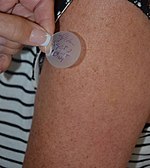தடுப்பு மருந்தேற்றம்


தடுப்பு மருந்தேற்றம் எனப்படுவது உடலில் நோய் எதிர்ப்பாற்றல் முறைமையைத் தூண்டி, அதன்மூலம் பிற்காலத்தில் ஏற்படக்கூடிய தொற்றுநோயை தடுப்பதற்காக உடலினுள் பிறபொருளெதிரியாக்கி ஒன்றை செலுத்தி நிருவகிக்கும் முறையாகும். அதாவது
சில தொற்றுநோய்களிலிருந்து உடலைப் பாதுகாத்துக் கொள்வதற்காக, நோய் வருவதற்கு முன்னராகவே தடுப்பு மருந்து அல்லது பிறபொருளெதிரியாக்கி பதார்த்தத்தை பயன்படுத்தும் சிகிச்சை முறையாகும். பல தொற்றுநோய்களுக்கான சிகிச்சை முறையில் தடுப்பு மருந்தேற்றமானது மிகவும் ஆற்றல் வாய்ந்ததாகக் கருதப்படுகின்றது.
இங்கு பயன்படுத்தப்படும் மருந்து, உயிருள்ள, ஆனால் பலவீனமாக்கப்பட்ட சில நுண்ணுயிரியாகவோ, அல்லது கொல்லப்பட்ட நுண்ணுயிரியாகவோ அல்லது நுண்ணுயிரியில் இருந்து பெறப்படும் நச்சுப்பொருள் பதார்த்தமாகவோ இருக்கும்.
பல நோய்க்காரணிகளால் ஏற்படுத்தப்படும் தொற்றுநோய்களின் தாக்கம் இந்த தடுப்பூசி முறையால் கட்டுப்படுத்தப்படும். இன்ஃபுளுவென்சா,[1] கருப்பப்பை வாய்ப் புற்றுநோய்[2], சின்னம்மை[3] போன்ற பல தீ நுண்மத்தால் ஏற்படும் தொற்றுநோய்கள் இப்படி கட்டுப்பாட்டுக்குள் கொண்டு வரப்பட்டுள்ளன. தடுப்பு மருந்தேற்றம் மூலம் பரந்துபட்ட நோய் எதிர்ப்பாற்றலை ஏற்படுத்தி அதன் மூலம் உலகளவில் சின்னம்மையை அழிக்க முடிந்ததுடன், இளம்பிள்ளை வாதம், தட்டம்மை, ஏற்புவலி (en:Tetanus) போன்றவற்றை உலகின் பல பகுதிகளிலும் கட்டுப்பாட்டுக்குள் கொண்டுவர முடிந்தது.
1796 இல் எட்வார்ட் ஜென்னர் என்பவரால் இந்த 'தடுப்பு மருந்து' என்ற சொல் பயன்படுத்தப்பட்டது. பின்னர் லூயி பாஸ்ச்சர் தனது நுண்ணுயிரியல் ஆய்வுகளில் தொடர்ந்து இந்த பதத்தை பயன்படுத்தி வந்தார். முதன் முதலில் பசுக்களில் தீவீரமில்லாத ஒரு வகை அம்மை நோயை ஏற்படுத்தும் ஒரு தீ நுண்மத்தில் இருந்து பெறப்பட்ட தடுப்பு மருந்து மனிதரில் தீவீர தொற்றும் தன்மையும், இறப்பை ஏற்படுத்தும் அளவுக்கு அபாயமானதுமான சின்னம்மை நோயைக் கட்டுப்படுத்த பயன்பட்டது.
இங்கே உடலினுள் பாதிப்பை விளைவிக்கவல்ல ஒரு பொருள் செலுத்தப்படுவதனால் இந்த மருத்துவ முறை தொடர்பில் பல சர்ச்சைகள், விவாதங்களும் நடைபெற்றன. தடுப்பு மருந்தேற்றத்தின் வினைத்திறனைக் கண்டறிய உலக ரீதியில் மிகப் பரந்துபட்ட அளவில் ஆய்வுகள் நடத்தப்பட்டன.[4][5][6] தொற்றுநோய்களிலிருந்து பாதுகாப்பைப் பெற தடுப்பு மருந்தேற்றம் மிகவும் பயன்தரும் முறை என அறியப்பட்டது;[7]
நோய் அழிப்பு[தொகு]
ஒரு குறிப்பிட்ட பகுதியில், மக்கள்தொகையின் போதுமானளவு வீதத்தினருக்கு தடுப்பு மருந்தேற்றம் செய்யப்படும்போது, நோய்த்தொற்றின் அளவில் ஏற்படும் வீழ்ச்சி காரணமாக, குறிப்பிட்ட நோய் இல்லாமல் அழிவதற்கான சாத்தியங்கள் ஏற்பட்டன. எடுத்துக்காட்டாக அமெரிக்காவில் போலியோவுக்கு எதிரான பரவலாகச் செய்யப்பட்ட தடுப்பு மருந்தேற்றம் மூலம் 1979 இல் போலியோ முழுமையாக நீக்கப்பட்டது.[8] உலகம் முழுவதிலுமே ஒரு நோய் இல்லாது செய்யப்படுமாயின், அது நோயழிப்பு எனப்படுகிறது. இவ்வாறு தடுப்பு மருந்தேற்றம் மூலம் உலகம் முழுவதும் இல்லாதொழிக்கப்பட்ட ஒரு நோய் சின்னம்மை ஆகும். பல பத்தாண்டு காலங்களாக உலக சுகாதார அமைப்பு சின்னம்மைக்கு எதிராக மேற்கொண்ட, தடுப்பு மருந்தேற்றத் திட்டத்தின் மூலம், 1980 இல் சின்னம்மை முற்றாக அழிக்கப்பட்டதாக World Health Assembly குறிப்பெழுதியுள்ளது. இதன்மூலம் உலக மக்கள்தொகையின் 35% மக்களின் இறப்புக்கும், இன்னொரு சதவீதத்தினரின் குருட்டுத் தன்மை, மற்றும் தழும்புகளுடனான உடலுடக்கும் காரணமாயிருந்த சின்னம்மை நோய் அழிக்கப்பட்டது.[8]
தடுப்பு மருந்தேற்ற வழிகள்[தொகு]

தடுப்பு மருந்தானது வெவ்வேறு வழிகளில் வழங்கப்படலாம்[9].
- வாய்மூலம் (Oral) வழங்கலாம்.
- ஊசிமூலம் (Injection) - இதனை தடுப்பூசி என்றழைப்பர். இது தசையினூடாக (Intramascular), தோலினூடாக (Intradermal), தோற்கீழ்ப் பகுதியினூடாக (Subcutaneous) செலுத்தப்படலாம்.
- தோலில் ஒட்டுப் போடுவதன் மூலம் தோலின் குறுக்காக (Transdermal) கொடுக்கலாம்.
- துளையிடுவதன் மூலம் (Puncture)
- மூக்கினூடாக (Intranasal)
இந்தியாவில் செயல்படுத்தப்படும் நோய்த் தடுப்பூசி திட்டங்கள்[10][தொகு]
| BCG | காசநோய்த் தடுப்பூசி |
| DPT | தொண்டை அடைப்பான், கக்குவான் இருமல், டெட்டானஸ் (முத்தடுப்பூசி) |
| MMR | புலட்டாலம்மை, மீசசல்ஸ், ரூபெல்லா (எம்எம்ஆர் தடுப்பு மருந்து) |
| DT | டிப்த்தீரியா(தொண்டை அடைப்பான்) |
| TT | டெட்டானஸ் டாக்ஸாய்டு |
மேற்கோள்கள்[தொகு]
- ↑ Fiore AE, Bridges CB, Cox NJ (2009). "Seasonal influenza vaccines". Curr. Top. Microbiol. Immunol. 333: 43–82. doi:10.1007/978-3-540-92165-3_3. பப்மெட்:19768400.
- ↑ Chang Y, Brewer NT, Rinas AC, Schmitt K, Smith JS (July 2009). "Evaluating the impact of human papillomavirus vaccines". Vaccine 27 (32): 4355–62. doi:10.1016/j.vaccine.2009.03.008. பப்மெட்:19515467.
- ↑ Liesegang TJ (August 2009). "Varicella zoster virus vaccines: effective, but concerns linger". Can. J. Ophthalmol. 44 (4): 379–84. doi:10.3129/i09-126. பப்மெட்:19606157.
- ↑ Fiore, Anthony E.; Bridges, Carolyn B.; Cox, Nancy J. (2009). "Seasonal influenza vaccines". Current Topics in Microbiology and Immunology 333: 43–82. doi:10.1007/978-3-540-92165-3_3. பன்னாட்டுத் தரப்புத்தக எண்:978-3-540-92164-6. பப்மெட்:19768400.
- ↑ Chang, Yuli; Brewer, Noel T.; Rinas, Allen C.; Schmitt, Karla; Smith, Jennifer S. (July 2009). "Evaluating the impact of human papillomavirus vaccines". Vaccine 27 (32): 4355–62. doi:10.1016/j.vaccine.2009.03.008. பப்மெட்:19515467.
- ↑ Liesegang, Thomas J. (August 2009). "Varicella zoster virus vaccines: effective, but concerns linger". Canadian Journal of Ophthalmology 44 (4): 379–84. doi:10.3129/i09-126. பப்மெட்:19606157.
- ↑ Sources:
- United States Centers for Disease Control and Prevention (2011). "A CDC framework for preventing infectious diseases", accessed 11 September 2012: "Vaccines are our most effective and cost-saving tools for disease prevention, preventing untold suffering and saving tens of thousands of lives and billions of dollars in healthcare costs each year."
- Gellin, Bruce, MD, MPH. "Vaccines and Infectious Diseases: Putting Risk into Perspective" பரணிடப்பட்டது 2010-11-24 at the வந்தவழி இயந்திரம். (Remarks at AMA Briefing on Microbial Threats.) American Medical Association. 1 June 2000. Accessed 4 September 2016. "Vaccines are the most effective public health tool ever created."
- Public Health Agency of Canada, "Vaccine-preventable diseases", accessed 11 September 2012: "Vaccines still provide the most effective, longest-lasting method of preventing infectious diseases in all age groups."
- United States National Institute of Allergy and Infectious Diseases (NIAID). "NIAID Biodefense Research Agenda for Category B and C Priority Pathogens", accessed 11 September 2012: "Vaccines are the most effective method of protecting the public against infectious diseases."
- ↑ 8.0 8.1 "Disease Eradication". The History of Vaccine. The College of Physicians of Philadelphia, BirthPlace of American Medicine. Last updated 25th January 2018. பார்க்கப்பட்ட நாள் 28 சனவரி 2018.
{{cite web}}: Check date values in:|date=(help) - ↑ Plotkin, Stanley A. (2006). Mass Vaccination: Global Aspects - Progress and Obstacles (Current Topics in Microbiology & Immunology). Springer-Verlag Berlin and Heidelberg GmbH & Co. K. பன்னாட்டுத் தரப்புத்தக எண்:978-3-540-29382-8.
- ↑ தமிழ்நாடு படநூல் கழகம் 10 வகுப்பு அறிவியல்
புற இணைப்புகள்[தொகு]
| தடுப்பு மருந்தேற்றம் பற்றிய நூலக ஆதாரங்கள் |
- U.S. government Vaccine Research Center: Information regarding preventive vaccine research studies
- The Vaccine Page பரணிடப்பட்டது 2009-04-14 at the வந்தவழி இயந்திரம் links to resources in many countries.
- Immunisation schedule for the UK. Published by the UK Department of Health. (PDF)
- CDC.gov - 'National Immunization Program: leading the way to healthy lives', US Centers for Disease Control (CDC information on vaccinations)
- CDC.gov - 'Mercury and Vaccines (Thimerosal)', US Centers for Disease Control
- CDC.gov - Vaccines timeline
- Immunize.org - Immunization Action Coalition' (nonprofit working to increase immunization rates)
- WHO.int - 'Immunizations, vaccines and biologicals: Towards a World free of Vaccine Preventable Diseases', World Health Organization (WHO's global vaccination campaign website)
- Health-EU Portal பரணிடப்பட்டது 2011-08-23 at the வந்தவழி இயந்திரம் Vaccinations in the EU
- History of Vaccines Medical education site from the College of Physicians of Philadelphia, the oldest medical professional society in the US
- Images of vaccine-preventable diseases
- Immunisation, BBC Radio 4 discussion with Nadja Durbach, Chris Dye & Sanjoy Bhattacharya (In Our Time, Apr. 20, 2006)

